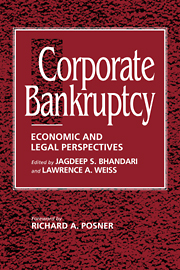Book contents
- Frontmatter
- Contents
- List of tables and figures
- Foreword by the HONORABLE RICHARD A. POSNER
- Preface
- Part I The role of credit
- 1 Leverage, Nobel Memorial Prize Lecture (1990)
- 2 Agency costs of free cash flow, corporate finance, and takeovers
- 3 A theory of loan priorities
- Part II Bankruptcy as a reflection of the creditors' implicit bargain
- Part III Beyond the basic creditors' bargain
- Part IV Workouts or bargaining in the shadow of bankruptcy
- Part V Alternatives to bankruptcy and the creditors' bargain
- Part VI Experience of other countries
- Index
1 - Leverage, Nobel Memorial Prize Lecture (1990)
Published online by Cambridge University Press: 10 December 2009
- Frontmatter
- Contents
- List of tables and figures
- Foreword by the HONORABLE RICHARD A. POSNER
- Preface
- Part I The role of credit
- 1 Leverage, Nobel Memorial Prize Lecture (1990)
- 2 Agency costs of free cash flow, corporate finance, and takeovers
- 3 A theory of loan priorities
- Part II Bankruptcy as a reflection of the creditors' implicit bargain
- Part III Beyond the basic creditors' bargain
- Part IV Workouts or bargaining in the shadow of bankruptcy
- Part V Alternatives to bankruptcy and the creditors' bargain
- Part VI Experience of other countries
- Index
Summary
The Private and Social Costs of Corporate Leveraging
The charge that the United States became overleveraged in the 1980s will strike some as perhaps too obvious to require any extensive documentation. What could offer more compelling evidence of the overissuance of debt than the defaults of so many junk-bond issuers in late 1989, with news of additional or pending defaults now almost a daily occurrence?
Junk bonds as just another risky security
To argue in this all-too-natural way, however, is to put too much emphasis on the word “bond” and not enough on the word “junk.” Bonds are, indeed, promises to pay. And certainly the issuers of the bonds hoped to keep those promises. But if the firm's cash flow, for reasons competitive or cyclical, fails to cover the commitments, then the promises cannot be kept, or at least not kept in full.
The buyers of the junk bonds, of course, also hoped that the promises would be kept. But they clearly weren't counting on it! For all save the most hopelessly gullible, the yields expected (in the sense of yield outcomes weighed by probability of occurrence) on junk bonds were below the nominal or promised yields. The high promised yields that might be earned during the good years were understood as compensation for the possible bad years in time and bad bonds in the total junk bond portfolio. The high nominal yields, in short, were essentially risk premiums. And in 1989, for many of the junk bonds issued earlier, the risk happened.
- Type
- Chapter
- Information
- Corporate BankruptcyEconomic and Legal Perspectives, pp. 3 - 10Publisher: Cambridge University PressPrint publication year: 1996



